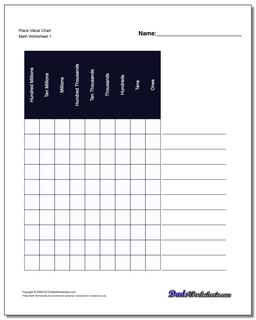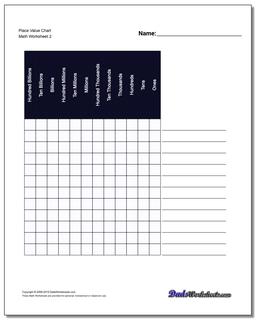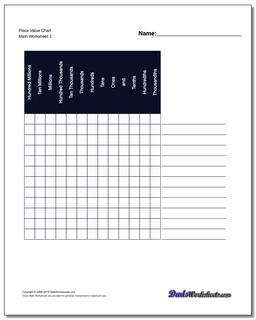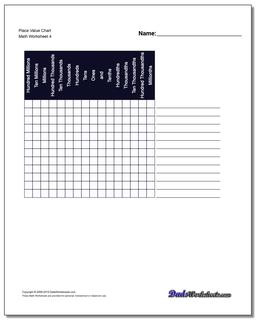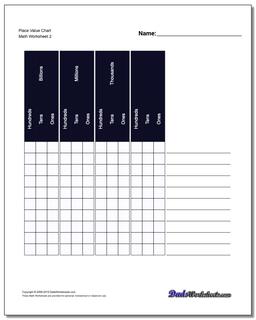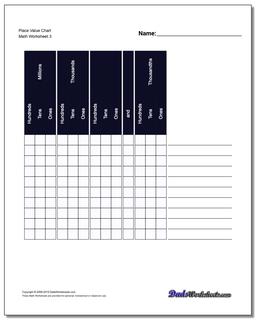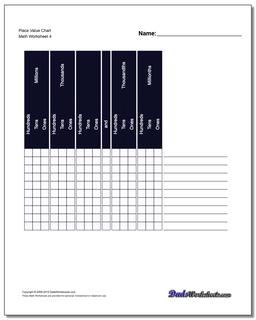Core Math Worksheets
Fraction Worksheets
Word Problems
Algebra and Trigonometry
Other Worksheets
Place Value
Percentages
Rounding Numbers
Ordering Numbers
Standard, Expanded, Word Form
Mean Median Mode Range
Ratio Worksheets
Probability Worksheets
Roman Numerals
Factorization, GCD, LCM
Prime and Composite Numbers
Pre-Algebra
Geometry Worksheets
Blank Clocks
Telling Analog Time
Analog Elapsed Time
Greater Than and Less Than
Money
Arithmetic Sequences
Geometric Sequences
Venn Diagram
Graph Worksheets
Measurement & Conversions
Patterns and Puzzles
Color by Number
Holiday & Seasonal
Early Learning
Printables
Calculators
Place Value Chart
This page has printable place value charts in PDF format including versions with period grouping and decimals. In the decimal numbering system, the position (or 'place') of an individual digit in a number determines its value relative to other digits. When a number is written in standard form with groups of three place values separated by commas, each of those groups is called a period. Building number sense by understanding place values is an important early math skill, and these place value charts provide a way to break numbers down to better understand the significance of each digit. There are place value chart variations for whole numbers only, decimal numbers, and very large numbers. There are different place value chart layouts that reinforce just the place value as well as the period value.
Place Value Chart
Place Value Charts with Period Groupings
What is Place Value?
When examining a number, every digit has a value that corresponds to its position relative to the other digits. Not all six digits are the same... If a six is in the one's place value, its value is 6... A six that is a couple of places over in the same number would have a value of 600 if it appears in the hundreds place.
This concept of individual digits having different absolute values is place value and it allows a number as a whole to represent many more values than just the ten basic digits allow on their own. The base 10 numbering system allows each additional digit in a number to increase the possible quantities that can be represented by a factor of 10, and a place value chart shows you how to easily read and recite those big numbers. Moving left increases the significance of each digit by a power of ten, and moving each digit right decrees that digit by a power of ten.
Decimal Place Values
Place value doesn't just exist to the left of the decimal point. Place values to the right of the decimal are called decimal place values, and they place an important role in converting between base 10 fractions and decimals. For some really great practice with decimal place value conversion, try these fraction decimal percent worksheets.
What are Place Value Periods?
When dealing with place value, we group sets of places into set of three digits, for example the 'thousands' group or the 'millions group' typically separated by commas. For example, in the number 123,456 we will read the first three digits as 'one hundred twenty three thousand' and those three digits are referred to as the thousands period. We read these numbers just as we normally read a three digit number ("one hundred twenty three") but then we attached the appropriate period name (thousands, millions, billions and so on.). The place value charts on this page include versions where the periods are emphasized in order to teach the concept, including two versions of the place value chart with wholes and two versions of the place value chart with decimals
Using a Printable Place Value Chart
You can use a place value chart to help teach students how to write a number in word form, and a place value chart can be a great help when doing activities like the expanded form worksheets on this site. Place value concepts and expanded, standard and word form conversions are skills that students in 2nd and 3rd grade should be readily familiar with, and a place value chart is often an good inclusion in student math binders for these grades.
Decimal Place Value and the Tricky Tenths Place
One common pitfall in learning decimal place value is figuring out that the first digit to the left of the decimal is the 'ones place' however the first digit to the right of the decimal is the 'tenths' place. This seeming lack of symmetry is a common stumbling block for 4th and 5th grade students, and a place value chart can be a ready way to help combat this confusion. by virtue of needing some sort of power of ten divisor for decimal place values, the first fractional place value position is the tenths position, and until this is memorized students may struggle navigating over the decimal place.
Worksheet History









